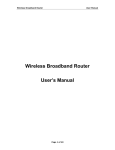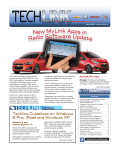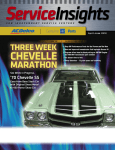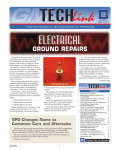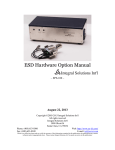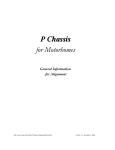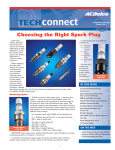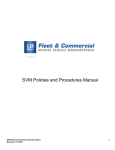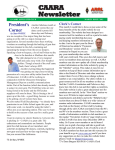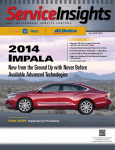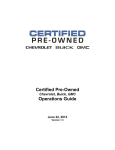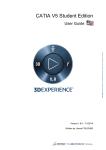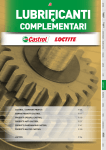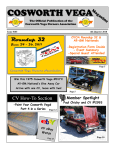Download 096 Sept Techlink 2010_Sept 2010 Techlink
Transcript
September 2010 Volume 12, No.9 2011 Chevrolet Cruze Cruze LTZ Cruze Eco It’s been a picture of success across Europe and Asia, and now it’s coming to America via Lordstown, Ohio. Designed, built and sold globally, the new 2011 Cruze is Chevrolet’s latest entry in the compact car segment in North America and it will offer much more than what is typically expected in a small car. Four models will be available: Eco, LS, LT and LTZ. The LS, equipped with the Ecotec 1.8L four-cylinder engine, and the LT and LTZ, equipped with the Ecotec 1.4L four-cylinder turbocharged engine, will be introduced this fall followed by the Eco (RPO 1XF), equipped with the Ecotec 1.4L turbo, later in the year. The Cruze features GM’s Global A electrical architecture, which requires use of the Global Diagnostic System (GDS) software and the Multi Diagnostic Interface (MDI) module. 6T40 six-speed automatic transmission (RPO MH8). The 1.4L turbo engine produces 138 horsepower and 148 lb.-ft. of torque. The turbocharger’s turbine housing is integrated within the exhaust manifold to reduce weight and provide better packaging in a smaller vehicle. The turbocharger is lubricated by engine oil and is liquid cooled. The pressurized air charge is cooled via an air-to-air intercooling system. 2011 Chevrolet Cruze . . . . . . . . . . . . . .1 The Techline Customer Support Center Covers IT . . . . . . . . . . . .3 The New GM dexos Engine Oil Specification . . . . . . . . . . . . . .4 Corvette Battery Charger Accessory . . . .5 Corvette Tire Vibration . . . . . . . . . . . . . .5 No Communication with the Immobilizer . .5 Programming with a USB Flash Drive . . . .6 Wet Floor or Mist from HVAC Vents . . . . .6 Correct Selection of Labor Codes . . . . . . .7 Ecotec 1.4L I-4 Turbo The Cruze is powered by a new generation of efficient, small-displacement four-cylinder engines. The Ecotec 1.4L turbo engine (RPO LUJ) with variable valve timing is paired with either the M32 six-speed manual transmission (RPO MZ0) or the Hydra-Matic Contents Ecotec 1.4L I-4 turbo engine In addition to the lighter, integrated turbocharger, other mass-reducing features of the 1.4L turbo include a cast iron block with a hollow frame structure (20% lighter than conventional casting), hollow-cast continued on page 2 Do Not Swap Control Modules . . . . . . . . .7 Fix It Right the First Time . . . . . . . . . . . .8 Service Know How . . . . . . . . . . . . . . . . .8 Customer Care and Aftersales 2011 Chevrolet Cruze – camshafts and a plastic intake manifold. The M32 six-speed manual transmission has wide ratios with a tall top gear to optimize fuel economy. Eco models with the six-speed manual transmission deliver a segment best 40 MPG highway (in Canada, an estimated 5.0L/100km). 6-Speed Automatic The Hydra-Matic six-speed automatic transmission uses a wide selection of shift patterns to adapt to varying driving styles and road conditions. The electronic controls will reduce gear shifting when driving on steep grades and uses engine brake assistance during downshift gear changes. It also features Driver Shift Control, which enables the driver to shift gears by tapping the shift lever up or down. To aid fuel economy, the transmission also has neutral gear disengagement at idle. This feature saves on fuel by automatically shifting the vehicle into a neutral state when the vehicle comes to a stop and the brake pedal is depressed. It shifts back to Drive as the brake pedal is released. Since the vehicle is in Neutral at a stop, the vehicle may roll back slightly when stopped on a hill before shifting into Drive. Eco Model The Cruze Eco has a number of technologies to enhance its efficiency, aerodynamics and fuel economy. These include: • A lower front grille air shutter that uses sensors to determine wind and temperature conditions, which activate electric motors that close the shutters at higher speeds to improve aerodynamics and open the shutters at lower speeds to optimize enginecooling airflow continued from page 1 Ecotec 1.8L I-4 Cruze LS models feature the naturally aspirated Ecotec 1.8L engine (RPO LUW) mated with either the M32 manual transmission or the Hydra-Matic 6T40 automatic transmission. The 1.8L engine also has many of the same features of the 1.4L turbo, including variable valve timing and a hollow-frame cast iron cylinder block. It generates 138 horsepower and 125 lb.-ft. of torque. The two-stage variable intake manifold balances fuel economy and performance needs. At engine speeds below 4,000 rpm, inlet air passes through 35.8-inch long intake tracts that help increase torque. At speeds above 4,000 rpm, a rotary sleeve in the manifold closes off the full length of the tracts, forcing air through a shorter 10.2-inch path that helps build horsepower. Both Ecotec engines have a cartridgestyle oil filter that is easier to recycle and service than canister-style filters. The filter housing is located near the top of the engine and is used for the life of the engine. The screw-on oil filter cap eliminates the canister-to-engine mating surface that is a potential source of leaks. The steering system is a dual pinion rack-mounted electric power system. Rear Suspension The patented rear suspension design incorporates a torsion beam-compound crank rear axle with a Watts linkage system for better side-to-side wheel control and greater stability and handling response. A tuning element tube (except on Eco models) is welded to the trailing arms and attached to the body through new hydraulic ride bushings for superior road noise and vibration isolation. On various models, 16-, 17- or 18-inch wheels are available. 16-, 17- and 18-inch (shown) wheels are available Front Suspension The front suspension of the Cruze is a fully independent, decoupled MacPherson strut design where normal damper loads are decoupled from the harsh jounce loads for better isolation and ride control. Interior Features Cruze features Bluetooth®, USB connectivity and an available navigation system. The USB port and a 3.5mm auxiliary input jack are located in the center console. The optional navigation system does not have a touch screen. Configuration and navigation menus are highlighted using the directional buttons on the center of the faceplate. Press the right Menu knob to select the highlighted menu or setting. MacPherson strut front suspension Lower control arms and front knuckles are lightweight aluminum for better wheel control on rough surfaces. New hydraulic ride bushings improve noise, vibration and harshness. Air shutter system Use the directional buttons to access the navigation system menus. • A lowered ride height and a lower front air dam extension, underbody panels and a rear spoiler to enhance aerodynamics • Unique 17-inch aluminum wheels with ultra-low rolling resistance tires The available automatic climate controls feature an Air Quality Sensor (AQS) that monitors incoming air quality, which is especially useful in heavy traffic. The HVAC Torsion beam rear suspension with Watts linkage 2 continued on page 3 September 2010 The Techline Customer Support Center Covers IT control module evaluates the information of the air quality sensor and closes the recirculation flap as soon as the concentration of pollutants exceeds a predeThe automatic climate controls fined value. have an Air Quality Sensor. It can be turned on using the AQS button on the climate controls. AQS will turn off any time the system is not in Auto mode. TIP: The sensitivity of the AQS can be adjusted. Press the Config button on the audio system and select Climate and Air Quality > Air Quality Sensor. To help quickly resolve programming events and assist in diagnosing potential product issues at dealerships, the Techline Customer Support Center (TCSC) in Pontiac, Mich., uses resources throughout GM. TCSC representatives work in conjunction with GM Techline Brand Quality, GM Techline Product Development, GM Milford Worldwide Service Programming (WSP) Engineering, the GM Field Service Engineering Team (FSE) and the GM Goodwrench Technical Assistance Center (TAC) to help dealership technicians with all kinds of vehicle service programming repairs. In addition, TCSC provides Information Technology (IT) troubleshooting and resolution for all Techline software applications related to GM North American vehicles, including calibration issues, scan tools, dealer PC hardware, dealer Internet and infrastructure connectivity. Safety All Cruze models will have 10 standard airbags, including dual-stage frontal airbags, head curtain side airbags, seatmounted front and outboard rear seat side-impact airbags, and front knee airbags. The StabiliTrak electronic stability control incorporates rollover sensing, traction control and antilock braking. Child safety locks also are standard equipment. The lockout switch on the driver’s door disables the interior rear door handles and the rear window switches. TIP: The child safety locks button indicator illuminates when the rear door safety locks are engaged. The indicator will flash if there is a system malfunction. Case Escalation One of the new areas supported within TCSC in the U.S. is the National Dispatch Command Center (NDCC). It is staffed with experienced resources that coordinate case dispatching to the GM Field Service Engineering (FSE) Team to escalate unresolved cases for both TCSC and TAC. (See the July edition of TechLink.) NDCC staff review all TCSC and TAC cases for accuracy and content pertaining to the dealer, city, state and vehicle. Cases are checked for prior FSE involvement and whether the FSE was requested by a Brand Quality Manager (BQM), Fixed Operations Manager (FOM), GM Customer Activities Manager (CAM), etc. The NDCC will perform additional research as needed for any cases and assign the best available resource. This group has been instrumental in providing expedited case dispatch to FSE, notification of assigned FSE, and case resolution. Spare Tire Option The trunk release touchpad is located in the center of the decklid above the license plate. A temporary spare tire or a tire sealant and compressor kit, depending on the model, is stored under the trunk floor. To access the spare tire, lift up the trunk floor using the pull tab in the Tire sealant and compressor kit front-center of the floor. Hook the tab on the top of the trunk weatherstrip to hold up the floor while removing the spare tire. To access the tire sealant and compressor kit, lift up the trunk floor. At the rear of the trunk well, turn the two knobs to a vertical position to unlock the access cover. Support Structure TCSC is available Monday – Friday, 8:00 AM – 8:00 PM ET. Multilingual (English, French, Spanish) support is available. All representatives collaborate with on-site specialists in numerous Techline product areas and support service programming for all model year GM vehicles. As part of the efforts to continually improve services, TCSC conducts a monthly random sample survey that is sent to GM dealership technicians served. Any response other than completely satisfied will result in a TCSC leadership team contacting the dealership service department to address potential areas for improvement. Contact TCSC To contact TCSC for support, dial direct to 1-800-828-6860 or call 1-888-337-1010, prompt #3, and follow the streamlined prompts for the specific area of assistance required. In Canada, call 1-800-828-6860 (English) or 1-800-503-3222 (French). Service Training Several service training courses on various Cruze components and systems are available, including: 10210.17W TCSC will now be requesting the email addresses of the callers to survey callers directly about their experience. This is a change from sending a paper survey to the Service Manager once resolution of the call is completed. 2011 Chevrolet Cruze New Model Features 16440.16D Engines: New & Updates for RPOs LUJ, LUW Go to www.gmtraining.com (or www.gmprocanada.com in Canada) for more information on Cruze service training. – Thanks to Tom Arnold, TIS & Techline Support – Thanks to Marty Case September 2010 3 The New GM dexos Engine Oil Specification in fuel economy versus the Sequence VIB that was used for GF-4. For the 2011 model year, GM will introduce dexos1™ certified engine oil as a factory fill and service fill for many engines. The reason for the new engine oil specification is three-fold: meet environmental goals such as increasing fuel efficiency and reducing engine emissions, promote long engine life, and minimize the number of oil changes to help meet the goal of lowering the industry’s overall dependence on crude oil. dexos2 was introduced in Europe late last year for diesel engines as well as a service fill for gasoline engines. It replaces the GM-LL-B-025 and GM-LL-A-025 (in Europe) specifications. dexos is a GM-developed engine oil specification that has been designed to: GF-5 Standard • Further improve fuel economy (to meet future Corporate Average Fuel Economy, CAFE, requirements) and fuel economy retention, which allows the oil to maintain its fuel economy benefits throughout the life of the oil • Provide a more robust formulation for added engine protection and aeration performance • Support GM’s Engine Oil Life System (EOLS) and minimize use of engine oil • Ensure worldwide availability of high quality oil for factory and service fill needs • Reduce the duplication of requirements for a large number of internal GM engine oil specifications TIP: The oil specified in prior model years remains acceptable for previous models; however, dexos1 is backward compatible for older vehicles. If dexos1 is not available, acceptable substitute engine oil for 2011 models includes: • SAE-5W-30 viscosity grade oil displaying the API Starburst symbol for all 2011 model year vehicles with naturally-aspirated engines, except Corvette, Camaro SS (with LS3 engine) and CTS-V • SAE 5W-30 viscosity grade oil meeting the GM4718M specification (such as Mobil 1 Full Synthetic) for 2011 model year Corvette, Camaro SS (with LS3) engine, CTS-V and vehicles with turbocharged engines dexos Classifications The dexos specification includes two classifications. GM will require dexos1 for global factory fill in spark ignited engines worldwide and service fill for gasoline engines worldwide, except in Europe. It will replace the GM6094M, GM4718M and GM-LL-A-025 specifications for most GM gasoline engines. In addition to GM dexos, a new International Lubricants Standardization and Approval Committee (ILSAC) standard, GF-5, will be introduced in October 2010. There will be a corresponding API category – SN Resource Conserving. The current GF-4 standard was put in place in 2004. The GF-5 standard will use a new fuel economy test, Sequence VID, which provides a statistically significant increase Here’s a sample of the dexos specification from a 2011 GM owner manual: Specification Use and ask for engine oils with the dexos™ certification mark. Oils meeting the requirements of your vehicle should have the dexos™ certification mark on the container. This certification mark indicates that the oil has been approved to the dexos™ specification. Notice: Use only engine oil that is approved to the dexos™ specification or an equivalent engine oil of the appropriate viscosity grade. Engine oils approved to the dexos™ specification will show the dexos™ symbol on the container. Failure to use the recommended engine oil or equivalent can result in engine damage not covered by the vehicle warranty. If you are unsure whether your oil is approved to the dexos™ specification, ask your service provider. Use of Substitute Engine Oils if dexos™ is unavailable: In the event that dexos™ approved engine oil is not available at an oil change or for maintaining proper oil level, you may use substitute engine oil displaying the API Starburst symbol and of SAE 5W-30 viscosity grade. Use of oils that do not meet the dexos™ specification, however, may result in reduced performance under certain circumstances. It’s expected that all dexos1 approved oils will meet GF-5. However, not all GF-5 engine oils will necessarily meet the dexos1 specification. Like dexos, the new ILSAC GF-5 standard will call for more sophisticated additives. The API will begin licensing marketers (the first license is expected October 2010) to produce and distribute GF-5 certified products, which are expected to include SAE 0W-20, 0W-30, 5W-20, 5W-30 and 10W-30 oils. Fuel Economy Since CAFE standards were first introduced in 1974, the fuel economy of cars has more than doubled, while the fuel economy of light trucks has increased by more than 50%. Proposed CAFE standards call for a continuation of increased fuel economy in new cars and trucks. To meet these future requirements, all aspects of vehicle operation are being looked at more critically than ever before. New technology being introduced in GM vehicles designed to address vehicle efficiency and fuel economy include direct injection, cam phasing, turbocharging and Active Fuel Management. The demands of these technologies on engine oil also are taken into consideration when determining new oil specifications. Active Fuel Management, for example, can help to achieve improved fuel economy, however, alternately starting and stopping cylinders puts a lot of stress on engine oil. Another industry trend for meeting tough fuel economy mandates has been a shift toward lower viscosity oils. Testing has shown that thinner 0W-20 oil can provide as much as a 4% improvement in fuel economy than 15W-40 oil. dexos1 will eventually be offered in several viscosity grades in accordance with engine needs: SAE 0W-20, 5W-20, 0W-30 and 5W-30. dexos 2 may be available in SAE 5W-30, 0W-40 and 5W-40, depending on engine needs. TIP: Using the right viscosity grade oil is critical for proper engine performance. Always check the appropriate vehicle owner manual for the proper viscosity grade for the vehicle being serviced. Increased Service Intervals To help reduce the consumption of oil while maintaining proper engine protection, many GM vehicles equipped continued on page 5 4 September 2010 Corvette Battery Charger Accessory Corvette owners who drive their vehicle infrequently now have a new option for keeping their vehicle’s battery charged and ready to go. The CTEK 3300 Battery Charger (RPO ERI) is a factory option for the 2011 model year. TIP: During the Pre-Delivery Inspection, ensure vehicles equipped with RPO ERI have the battery charger in the vehicle. It should include the charger, a manual and a charger bag. To operate the battery charger, simply plug in the charger to a standard electrical outlet and into the vehicle’s accessory power outlet. The charger is designed for charging lead-acid batteries from 2 to 90Ah. It uses a fully automatic four-step charging process that efficiently brings the battery up to a set level and then maintains it. The charging process begins with an almost constant current until maximum voltage (14.4V or 14.7V) is reached. At this point, the charger switches to constant voltage and the current supply to the battery is gradually reduced. If the current drops to battery, if desired, using the charger’s mounting holes. The low back-current drain means that without the power cord connected, the charger won't deplete the battery. Charging Time 0.4A, the charger switches to pulse maintenance. If the battery is charged and the terminal voltage of the battery falls to 12.9V, the charger automatically starts again at the first step. The charge indicator or the maintenance charge indicator illuminates when the charger is plugged in. When the maintenance charge indicator illuminates, the battery is fully charged. The 3300 battery charger can be safely connected for months at a time. There's no need to disconnect the battery while charging since it will not harm vehicle electronics, produces minimal gas buildup, is splash and dust proof, double-insulated and has temperature protection to prevent the charger from overheating. The 3300 battery charger is outdoorapproved and small enough to be permanently mounted next to the vehicle’s GM dexos Engine Oil – continued from page 4 with the GM EOLS have a maximum oil change interval that is much longer than what was considered a normal interval just a few years ago. If all GM vehicle owners would follow the EOLS intervals in their vehicles as intended, GM estimates that more than 100 million gallons of oil could be saved annually. The second generation EOLS will rely on significantly more engine operating information than the current system, which, combined with dexos approved oil, could allow a significant extension of the maximum oil change interval. dexos specifications call for improved oil robustness to support extended drain intervals over a vehicle’s lifetime. dexos1 Availability dexos1 will be available through the GM Goodwrench Oil Program along with a full line of products, including conventional GF-5 oil, Mobil 1 Full Synthetic and others. It will be available in 55 gallon drums (which can be pumped into bulk tanks) as well as packaged quarts. In Canada, dexos1 will be available through the ACDelco Oil Program in 205L drums and packaged 1 liters. More information about availability and part numbers will be coming soon. – Thanks to Matt Snider and Eric Johnson September 2010 The time required to charge a battery will vary depending upon the state of charge and temperature of the battery. A completely discharged battery requires more than twice as much charging time as a half charged battery. In a discharged battery with a voltage below 11 V, the battery has a very high internal resistance and may only accept a very low current at first. Later, as the charging current causes the acid content to increase in the electrolyte, the charging current will increase. In addition, the colder the battery temperature is, the more time it takes to recharge the battery. The charging current accepted by a cold battery is very low at first. As the battery warms, the charging current will increase. – Thanks to Brad Thacher Corvette Tire Vibration A slight vibration in the steering wheel may be noticed on 2009-2011 Corvette models when traveling between 72 and 78 MPH (116 and 126 km/h). The tires are known to flat spot when parked and this condition may be present until the tires warm up. This condition should clear up after approximately 30 minutes of driving. Prior to beginning diagnosis, drive the car for 30 minutes. Next, check the tires for force variation to determine which tire(s) may be contributing to the vibration. 15 lbs. (6.8 kg) is considering acceptable. Rotating the tires on the rim, called match mounting, may help reduce the force variation to below 12 lbs. (5.4 kg). Rotate the tire/wheel assembly on the hub one lug at a time and then test drive the vehicle. There can be a stack up of tolerance between the lug nuts and the lugs on the front hub, which can contribute to the vibration condition. If, after performing these procedures, a slight vibration still exists, it is considered a normal characteristic of the vehicle. – Thanks to Jeremy Richardson No Communication with the Immobilizer When diagnosing a no crank, no start condition on a 2009-2010 Vibe, a technician may find no communication with the immobilizer (vehicle theft module), nor can the immobilizer key exciter and/or immobilizer amplifier components be located. Check the vehicle’s RPOs in the Global Warranty Management System (GMVIS2). If the vehicle is built without RPO UA6 (vehicle theft deterrent), it is not equipped with an immobilizer system. This applies only to vehicles sold in the U.S. Follow the appropriate Service Information for a no crank, no start condition. – Thanks to Ernest Haller 5 Programming with a USB Flash Drive GM has recently introduced a new process to program some navigation audio systems using a USB flash drive. Recently, this new programming process has been used on 2010 SRX, LaCrosse, Equinox, Terrain and 2009-2010 CTS. The USB port on these vehicles is located in the center console storage compartment. As new models are developed with navigation systems and audio systems featuring USB ports and hard drives, more programming will be done using a USB flash drive. Dealerships will Some programming can be performed need to purchase a through the vehicle’s USB port. USB flash drive in order to use this new method for future USB programming events. The USB flash drive should have: USB Programming When using a USB flash drive in a vehicle, it is not a TIS2WEB programming event. Refer to the appropriate Service Information, bulletin or PI for complete USB programming instructions, including maintaining a battery charge during programming. Insert a USB flash drive Once the USB flash drive is in the computer and select inserted into the USB port on the the USB drive. vehicle, the navigation/audio system detects the software on the USB flash drive. Follow the on-screen prompts to complete the programming procedure. Also complete any other related procedures to ensure the navigation system and/or audio system controls function properly after programming. Once programming is comFollow the on-screen prompts pleted on one vehicle, the after inserting the USB flash software on the USB flash drive drive in the vehicle’s USB port. can be used for all other vehicles involved in a bulletin or repair procedure. Otherwise, the calibration can be deleted from the USB flash drive and used for future USB programming events. • A USB 2.0 interface or better • A minimum capacity of 512 MB • No other files installed on the drive prior to calibration download • No installed security software By programming through the USB port, the programming time is reduced, which is critical when many of the update files for the navigation systems are 10 to 50 MB in size. Using the conventional pass thru programming method to update files of this size can take up to three hours. – Thanks to Lisa Scott Wet Floor or Mist from HVAC Vents TIS2WEB-to-USB TIS2WEB has been updated to include a feature to allow you to download programming to a USB flash drive. For step-by-step instructions, refer to the Service Information and the Techline Information System (TIS) terminal. TIP: All data on the USB flash drive will be erased BEFORE the TIS2WEB-to-USB flash drive download process. Transfer any Some calibrations may be downloaded from data from the USB TIS2WEB to a USB flash drive. flash drive to another approved data storage drive before attempting to download a calibration from TIS2WEB. On the TIS terminal, the appropriate calibration can be downloaded onto the USB flash drive from the Supported Controllers screen. Once the calibration is selected, the USB flash drive should be inserted into the USB port on the computer. After selecting the USB drive, the calibration will be downloaded to the USB flash drive. TIP: Click the Refresh button if the USB drive is not selectable in the Available USB Drives box. Once the “Remove the USB stick” message is displayed, the files have been successfully downloaded and the USB flash drive can be removed from the computer. Kinked evaporator drain hose The HVAC evaporator drain hose may be kinked on some 2010 Escalade models, Avalanche, Silverado, Tahoe, Suburban, Sierra, Sierra Denali, Yukon, Yukon Denali, Yukon XL and Yukon XL Denali models, which may result in wet front passenger flooring, a water sloshing noise or mist coming from the instrument panel vents. To correct these conditions, reposition/rotate the kinked drain hose to clear the nearby heat shield. – Thanks to Ernest Haller 6 September 2010 Correct Selection of Labor Codes GM TechLink is a monthly magazine for all GM retail technicians and service consultants providing timely information to help increase knowledge about GM products and improve the performance of the service department. Publisher: Thomas J. Arnold GM Customer Care and Aftersales / [email protected] Editor: Lisa G. Scott GM Customer Care and Aftersales / [email protected] Technical Editor: Mark Spencer / [email protected] Production Manager: Marie Meredith 5by5 Design LLC / [email protected] 3 1-248-729-4704 Write to: * TechLink PO Box 500 Troy, MI 48007-0500 GM TechLink on the Web: GM GlobalConnect corresponding labor code. View Codes Desktop Publishing: FAX number: The correct selection of labor codes is important for accurate quality analysis of warranty claims and to ensure dealers and technicians are correctly compensated for the warranty repair time. This responsibility normally resides with the warranty administrator who reviews the comments of technicians and determines which labor code to assign to the warranty claim. Warranty administrators are well trained to find the correct labor code, but the process is very dependent upon how well the technician’s comments are understood. To simplify the selection of labor codes, a new enhancement to the Service Information (SI) is being made for the 2010 and 2011 model years that allows the technician to select the correct labor code based on the repair procedure being used in SI. A link has been established between repair procedures and the corresponding labor code and description. A couple of simple clicks from the service repair procedure will show the labor code, enabling the technician to add the labor code to the repair order. Once the correct labor code has been selected, the warranty administrator can quickly reference the labor time guide to determine the applicable time for the warranty claim. Click the link in the upper-right corner to access the : General Motors service tips are intended for use by professional technicians, not a “do-it-yourselfer.” They are written to inform those technicians of conditions that may occur on some vehicles, or to provide information that could assist in the proper service of a vehicle. Properly trained technicians have the equipment, tools, safety instructions and know-how to do a job properly and safely. If a condition is described, do not assume that the bulletin applies to your vehicle or that your vehicle will have that condition. See a General Motors dealer servicing your brand of General Motors vehicle for information on whether your vehicle may benefit from the information. Inclusion in this publication is not necessarily an endorsement of the individual or the company. Copyright© 2010 General Motors Company All rights reserved. From the service repair procedure in SI, click the new link in the upper right corner. From the pull-down menu, click Global Labor Time Guide: “labor time description.” Clicking this link will toggle to the corresponding labor time description and code. Click the link in the upper-right corner to To return to the service return to the repair procedure. repair instructions, click either the Back button or the same pull-down menu in the upper right corner and select Service Manual - “repair procedure title.” Technicians are encouraged to use this new enhancement to help simplify labor code selections and ensure that the correct code is chosen for the work performed. – Thanks to Mark Foucher Do Not Swap Control Modules A no start condition may result from swapping an ECM or other module from one vehicle to another if the vehicles use the Global Architecture electrical system (Global A). Global A vehicles include 2010-2011 LaCrosse (U.S. and Canada), SRX, Camaro, Equinox, Terrain, and 2011 Regal and Cruze. Swapping ECMs or other modules (including the BCM, EBCM, SDM, ECC, and IPC) on Global A vehicles will result in damaging both controllers and a no start condition will occur in both vehicles due to the new vehicle security code protocol (environment). For an overview of the Global Architecture electrical system and more information about the consequences of swapping modules, refer to the February 2010 edition of TechLink. – Thanks to Ernest Haller September 2010 7 Car Issues – Fix It Right the First Time Model Year(s) Vehicle Line(s) / Condition Do This Don’t Do This Reference Information / Bulletin 2010 LaCrosse – Intermittent remote memory seat recall operation Replace the driver’s seat adjuster memory module and reprogram the module Do not use the old part number PI0187 2009–2010 Aveo – Intermittent engine no crank Reprogram TDM with updated calibration Do not replace the TDM 10-08-56-001 2006–2010 Acadia; Avalanche; CTS; CTS-V; CTS Sport Wagon; CTS-V Sport Wagon; DTS; Enclave; Equinox; Escalade; Escalade ESV; Escalade EXT; Express; H2; H2 SUT; Impala; Lucerne; Outlook; Savana; Sierra; Silverado; SRX; Suburban; Tahoe; Torrent; VUE; Yukon; Yukon Denali; Yukon XL; Yukon XL Denali – RKE transmitter button inoperative or will not reprogram to vehicle Ensure buttons are not locked before replacing battery or fob Do not replace key fob before performing the unlock procedure 10-08-52-003 2008–2010 CTS; CTS-V; CTS Sport Wagon; CTS-V Sport Wagon – Windshield pillar garnish molding loose Use updated clip Do not use previous part number 09-08-110-008B 2005–2011 All Vehicles – TPMS system service and re-learning sensor IDs After driving with spare tire, when replacing with regular road tire, clear DIC message and TPM DTC’s using scan tool; perform TPM relearn Do not perform unnecessary repairs 10-03-16-001 2009–2011 All Vehicles – Vehicles on dealer lots for extended periods no start condition Refuel with fresh fuel Do not replace the ECM 09-06-04-015A 2005–2011 Corvette – Noise from roof panel while driving Clean weather strips prior to replacing any parts Do not replace handles on 2009–2011 roofs unless the handle is broken 08-08-67-013D 2010 Camaro – Accessory drive noise when A/C compressor cycles Always check drive belt alignment prior to replacement of belt for noise Do not replace belt without checking alignment 09-06-01-013B 2004–2010 Acadia; AURA; Enclave; Equinox; G6; LaCrosse; Malibu; OUTLOOK; Rendezvous; SRX; Terrain; Torrent; Traverse; VUE – Internal engine noise or damage after oil filter replacement When diagnosing engine noises, check aftermarket oil filter cartridges for oil starvation Do not perform warranty repairs when the damage was caused by an aftermarket oil filter 10–06–01–003A 2006–2010 STS – Front passenger airbag status indicator displays OFF with passenger in seat Chose the correct part based upon the customer profile Do not replace the PPS without considering the customer profile 07-09-41-001A Truck Issues – Fix It Right the First Time Model Year(s) Vehicle Line(s) / Condition Do This Don’t Do This Reference Information / Bulletin 2011 Sierra, Silverado – New model features and service guide Learn about the new model features Do not assume the features on the new HD model work the same way as the light-duty model 10-00-89-012 2005–2009 Canyon; Colorado – Excessive blower motor noise on low speed Install the molded insulator to the blower motor Do not replace the blower motor for noise 06-01-38-001C 2007–2010 Sierra; Silverado – Excessive wind noise coming from rear interior of vehicle Replace back of cab insulator with updated part Do not modify body pressure relief valve 10-08-58-001A 2007–2010 Sierra; Silverado – HO2S bank 2, sensor 2 pigtail harness wire chafing Install anti-abrasion tape to sensor lead Do not replace the O2 sensor without modifying the lead 10-06-04-009 2010–2011 Avalanche; Escalade; Escalade ESV; Escalade EXT; Sierra; Silverado; Suburban; Tahoe; Yukon; Yukon XL: Yukon Denali – Noise during full left turns Install tie strap to maintain cable position Do not replace the cable or wheelhouse liner PI0161 10210.09D Emerging Issues Service Know-How September 8, 2010 To view Emerging Issues seminars: Log in to www.gmtraining.com, select Service Know-How/TECHAssist from the menu, select Emerging Issues, and then Searchable Streaming Video to choose the current Emerging Issues seminar or past programs. 8 September 2010








